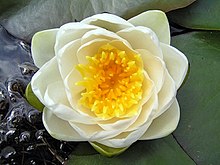

Aquatic plants are vascular plants that have adapted to live in aquatic environments (saltwater or freshwater). They are also referred to as hydrophytes or macrophytes to distinguish them from algae and other microphytes (phytoplanktons). In lakes, rivers and wetlands, aquatic vegetations provide cover for aquatic animals such as fish, amphibians and aquatic insects, create substrate for benthic invertebrates, produce oxygen via photosynthesis, and serve as food for some herbivorous wildlife.[1] Familiar examples of aquatic plants include waterlily, lotus, duckweeds, mosquito fern, floating heart, water milfoils, mare's tail, water lettuce and water hyacinth.
Although seaweeds, which are large multicellular marine algae, have similar ecological functions to aquatic plants such as seagrass, they are not typically referred to as macrophytes as they lack the specialized root/rhizoid system of plants.[2] Instead, seaweeds have holdfasts that only serve as anchors and have no absorptive functions.
Aquatic plants require special adaptations for prolonged inundation in water, and for floating at the water surface. The most common adaptation is the presence of lightweight internal packing cells, aerenchyma, but floating leaves and finely dissected leaves are also common.[3][4][5] Aquatic plants only thrive in water or in soil that is frequently saturated, and are therefore a common component of swamps and marshlands.[6] One of the largest aquatic plants in the world is the Bolivian waterlily, which holds the Guinness World Record of having the largest undivided leaf at 3.2 m (10 ft 6 in) diameter; the smallest is the rootless duckweed, which is only 1 mm (0.039 in) across. Many small animals use aquatic plants such as duckweeds and lily pads for spawning or as protective shelters against predators both from above and below the water surface.
Aquatic plants are important primary producers and are the basis of food web for many aquatic fauna, especially wetland species.[7] They compete with phytoplanktons for excess nutrients such as nitrogen and phosphorus, thus reducing the prevalence of eutrophication and harmful algal blooms, and have a significant effect on riparian soil chemistry[8] as their leaves, stems and roots slow down the water flow, capture sediments and trap pollutants. Excess sediment will settle into the stream bed due to the reduced flow rates, and some aquatic plants also have symbiotic microbes capable of nitrogen fixation and breaking down the pollutants trapped and/or absorbed by the roots.[9][2] Historically, aquatic plants have been less studied than terrestrial plants,[10] and management of aquatic vegetation has become an increasingly interested field[11] as means to reduce agricultural pollution of water bodies.[12][13]
- ^ "Macrophytes as Indicators of freshwater marshes in Florida" (PDF). Archived (PDF) from the original on 2014-04-07. Retrieved 2014-04-05.
- ^ a b Krause-Jensen, Dorte; Sand-Jensen, Kaj (May 1998). "Light attenuation and photosynthesis of aquatic plant communities". Limnology and Oceanography. 43 (3): 396–407. Bibcode:1998LimOc..43..396K. doi:10.4319/lo.1998.43.3.0396. ISSN 0024-3590. S2CID 85700950.
- ^ Sculthorpe, C. D. 1967. The Biology of Aquatic Vascular Plants. Reprinted 1985 Edward Arnold, by London.
- ^ Hutchinson, G. E. 1975. A Treatise on Limnology, Vol. 3, Limnological Botany. New York: John Wiley.
- ^ Cook, C.D.K. (ed). 1974. Water Plants of the World. Dr W Junk Publishers, The Hague. ISBN 90-6193-024-3.
- ^ Keddy, P.A. 2010. Wetland Ecology: Principles and Conservation (2nd edition). Cambridge University Press, Cambridge, UK. 497 p.
- ^ Chambers, Patricia A. (September 1987). "Light and Nutrients in the Control of Aquatic Plant Community Structure. II. In Situ Observations". The Journal of Ecology. 75 (3): 621–628. Bibcode:1987JEcol..75..621C. doi:10.2307/2260194. JSTOR 2260194.
- ^ "Do macrophytes play a role in constructed treatment wetlands?". Water Science and Technology. 35 (5). 1997. doi:10.1016/s0273-1223(97)00047-4. ISSN 0273-1223.
- ^ Cowardin, Lewis M.; Carter, Virginia; Golet, Francis C.; Laroe, Edward T. (2005-07-15), "Classification of Wetlands and Deepwater Habitats of the United States", in Lehr, Jay H.; Keeley, Jack (eds.), Water Encyclopedia, John Wiley & Sons, Inc., pp. sw2162, doi:10.1002/047147844x.sw2162, ISBN 9780471478447, archived from the original on 2019-12-21, retrieved 2019-11-16
- ^ Maréchal, Eric (2019). "Marine and Freshwater Plants: Challenges and Expectations". Frontiers in Plant Science. 10: 1545. doi:10.3389/fpls.2019.01545. ISSN 1664-462X. PMC 6883403. PMID 31824548.
- ^ Nichols, Stanley A. (February 4, 1974). "Mechanical and Habitat Manipulation for Aquatic Plant Management: A Review of Techniques". Department of Natural Resources – via Google Books.
- ^ Quilliam, Richard S.; van Niekerk, Melanie A.; Chadwick, David R.; Cross, Paul; Hanley, Nick; Jones, Davey L.; Vinten, Andy J.A.; Willby, Nigel; Oliver, David M. (April 2015). "Can macrophyte harvesting from eutrophic water close the loop on nutrient loss from agricultural land?". Journal of Environmental Management. 152: 210–217. Bibcode:2015JEnvM.152..210Q. doi:10.1016/j.jenvman.2015.01.046. hdl:10023/6517. PMID 25669857.
- ^ Verhofstad, M.J.J.M.; Poelen, M.D.M.; van Kempen, M.M.L.; Bakker, E.S.; Smolders, A.J.P. (September 2017). "Finding the harvesting frequency to maximize nutrient removal in a constructed wetland dominated by submerged aquatic plants". Ecological Engineering. 106: 423–430. Bibcode:2017EcEng.106..423V. doi:10.1016/j.ecoleng.2017.06.012.